Dogs hold a special place in many hearts, often considered cherished family members. However, for individuals with allergies, the dream of owning a canine companion can often be overshadowed by concerns about allergic reactions. This is where the appeal of dog breeds that don’t shed hair becomes evident, offering a potential solution for allergy sufferers to experience the joy of pet ownership. While no dog is entirely allergen-free, certain breeds produce significantly less dander and shed minimal hair, making them a much better fit for sensitive individuals. Understanding what constitutes a “low-shedding” or “hypoallergenic” dog and exploring specific breeds can help prospective pet parents make informed decisions. dog breed that doesn t shed hair
Understanding Low-Shedding Dog Breeds
The term “hypoallergenic” is often used to describe dogs that are thought to be more suitable for people with allergies. However, it’s crucial to understand that all dogs produce allergens. These allergens are primarily found in a dog’s dander (dead skin cells), saliva, and urine, not just their hair. What makes certain breeds more “allergy-friendly” is their coat type, which tends to shed less hair and, consequently, less dander into the environment. This reduction in airborne allergens can significantly minimize the triggers for allergic responses such as sneezing, itching, or wheezing. Therefore, when we talk about dog breeds that don’t shed hair, we are referring to those that release fewer allergens, making life easier for those with sensitivities.
Best Dog Breeds That Don’t Shed Hair
While no dog is 100% allergen-free, many breeds are specifically noted for their low-shedding qualities, making them excellent choices for individuals with allergies. These dogs require specific grooming routines to keep their coats healthy and minimize any potential allergen release.
1. Poodle
Poodles are renowned for their elegant appearance and exceptional intelligence. Available in three sizes—Standard, Miniature, and Toy—each variety is celebrated for its low-shedding coat. Originally bred as water retrievers, Standard Poodles are the largest, while Miniature and Toy Poodles were developed to be smaller companions. These dogs shed very little, thanks to their curly, dense coats that trap loose hair and dander, preventing it from spreading throughout the home. However, their unique coats require regular grooming, including frequent brushing to prevent matting and professional clipping every few weeks. Without proper care, their curls can quickly become tangled and matted, potentially leading to skin issues. long haired dog breeds that dont shed
2. Yorkshire Terrier
Yorkshire Terriers, affectionately known as Yorkies, are small dogs with big personalities. These spunky and affectionate pups are considered low-shedding, making them a popular choice for allergy sufferers. Their fine, silky hair is more akin to human hair than typical dog fur, and it sheds minimally. Yorkies are highly adaptable, thriving in various living situations, from spacious homes to cozy apartments, provided they receive ample attention and mental stimulation from their families. Despite their small size, they have a confident demeanor and enjoy being the center of attention. Regular brushing is necessary to keep their long, flowing coats free of tangles and looking their best.
 A small blue and tan Yorkshire Terrier lounging comfortably on an armchair in a home setting
A small blue and tan Yorkshire Terrier lounging comfortably on an armchair in a home setting
3. Shih Tzu
The Shih Tzu is an ancient companion breed known for its luxurious double coat and friendly temperament. Despite their thick hair, Shih Tzus are considered low-shedding, with most loose hairs getting caught within their voluminous coats. These charming small dogs are bred solely to be companions and thrive on human interaction. Their affectionate and outgoing nature makes them wonderful family pets. However, their distinctive flat faces can predispose them to certain health issues, including breathing difficulties, overheating, and tear stains around their eyes. Daily brushing and regular grooming are essential to maintain their coat’s health and prevent mats.
4. Miniature Schnauzer
The Miniature Schnauzer is the smallest of the three Schnauzer breeds, typically standing no more than 14 inches tall and weighing between 10–20 pounds. These intelligent and robust dogs possess a wiry, low-shedding coat that makes them suitable for many people with allergies. Their compact size allows them to adapt well to various living environments, from urban apartments to country homes. Miniature Schnauzers are active dogs that require at least an hour of exercise daily to stay happy and healthy. Their distinctive eyebrows and beard add to their charming appearance, but these features also require regular trimming and grooming to keep them neat.
5. Standard Schnauzer
Larger than their miniature counterparts, Standard Schnauzers share many of the appealing qualities that make Miniature Schnauzers excellent pets. They can weigh up to 45 pounds and possess the same wiry, low-shedding coat. Standard Schnauzers are energetic and highly intelligent dogs that thrive on activity. They enjoy long walks, engaging games of fetch, and interactive puzzle toys that challenge their minds. Their playful and protective nature makes them excellent family guardians. Like all Schnauzers, they benefit from regular grooming, including stripping or clipping to maintain their coat’s texture and minimize shedding.
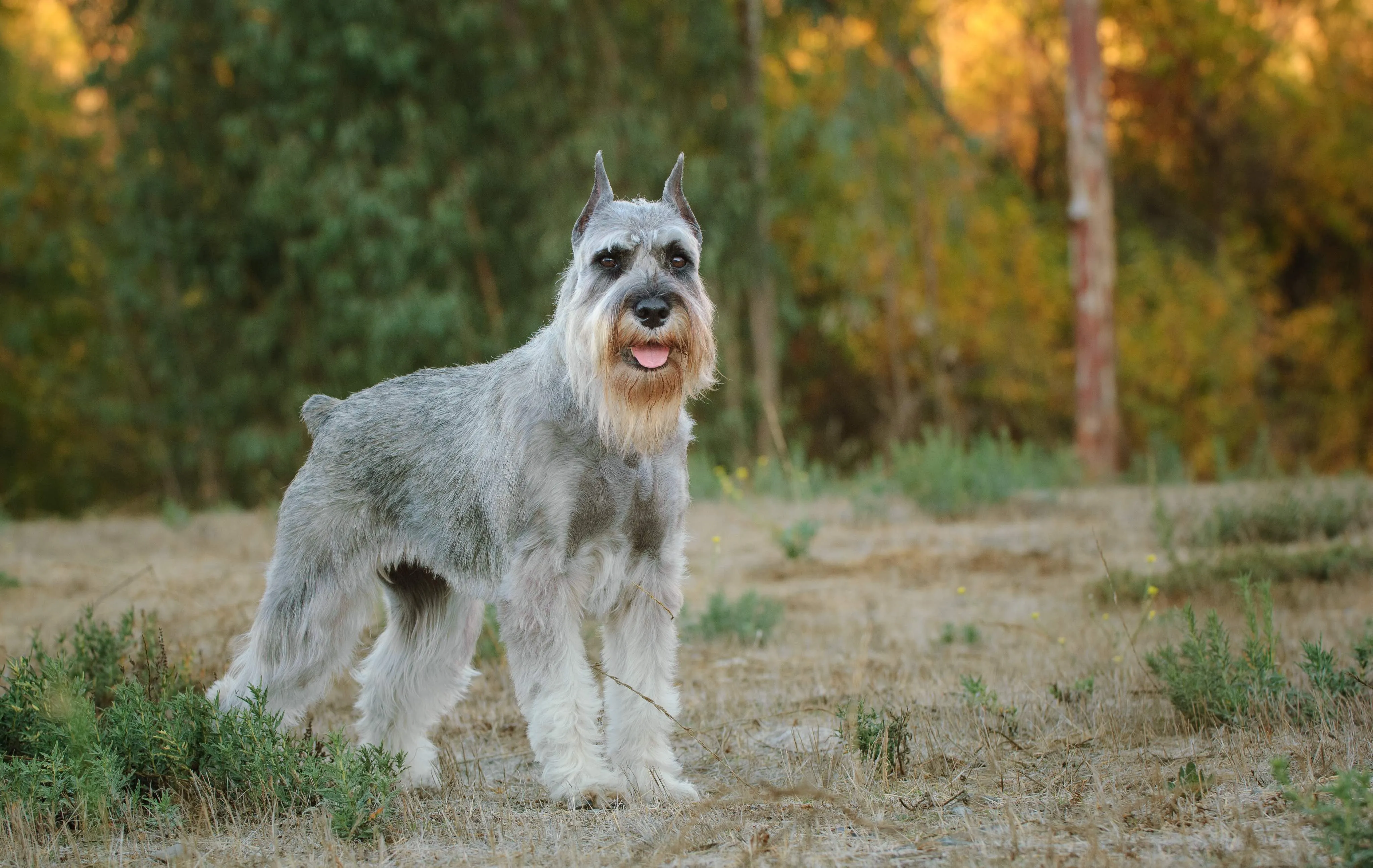 A stately gray Standard Schnauzer standing attentively in a lush green field on a sunny day
A stately gray Standard Schnauzer standing attentively in a lush green field on a sunny day
6. Giant Schnauzer
Giant Schnauzers are among the largest of the low-shedding dog breeds, capable of reaching heights over 27 inches and weighing up to 85 pounds. Despite their imposing size, they share the characteristic wiry, low-shedding coat of their smaller relatives. These powerful and energetic dogs require substantial exercise to maintain their physical and mental well-being. Activities such as long walks, strenuous runs, weekend hikes, and vigorous games of fetch are crucial for keeping a Giant Schnauzer happy and preventing boredom, which can lead to destructive behaviors. Their strong protective instincts make them excellent watchdogs, but they also possess a loyal and loving disposition towards their families.
7. Bichon Frise
The Bichon Frise is a cheerful, small dog known for its playful and affectionate nature. Their signature curly, powder-puff coat is not only adorable but also low-shedding, making them a popular choice for individuals with allergies. Bichons are highly intelligent and eager to please, which makes them exceptionally trainable. They respond well to positive reinforcement and can quickly master basic commands and even learn a variety of fun tricks to entertain their families. Despite their small stature, they are robust and enjoy active play. Regular grooming, including daily brushing and professional clipping, is essential to prevent their soft curls from matting.
8. Chinese Crested
Chinese Crested dogs are small breeds distinguished by their unique appearance, offering two distinct varieties: Hairless and Powderpuff. Both types are considered low-shedding. The Hairless variety has smooth, soft skin with tufts of hair only on their head, tail, and paws, while the Powderpuff is covered in a full coat of long, silky hair. Regardless of the variety, Chinese Crested dogs are playful, affectionate, and make wonderful companions. Their small size makes them adaptable to various living situations, and their loving nature ensures they form strong bonds with their owners. The Hairless variety requires skin care to protect against sunburn and dryness, while the Powderpuff needs regular brushing. mini dog breeds that don t shed
9. Portuguese Water Dog
Originally bred to assist fishermen in Portugal, the Portuguese Water Dog is a medium-sized breed known for its robust, curly coat that sheds minimally. This makes them a popular choice among dog breeds that don’t shed hair. They are highly intelligent, easily trainable, and possess a friendly disposition, making them excellent family pets. As their name suggests, these dogs have a strong affinity for water and are high-energy pups that thrive on regular exercise. Activities like swimming, long walks, and engaging games keep them healthy and content. Their water-resistant coat requires consistent grooming to prevent matting and maintain its health.
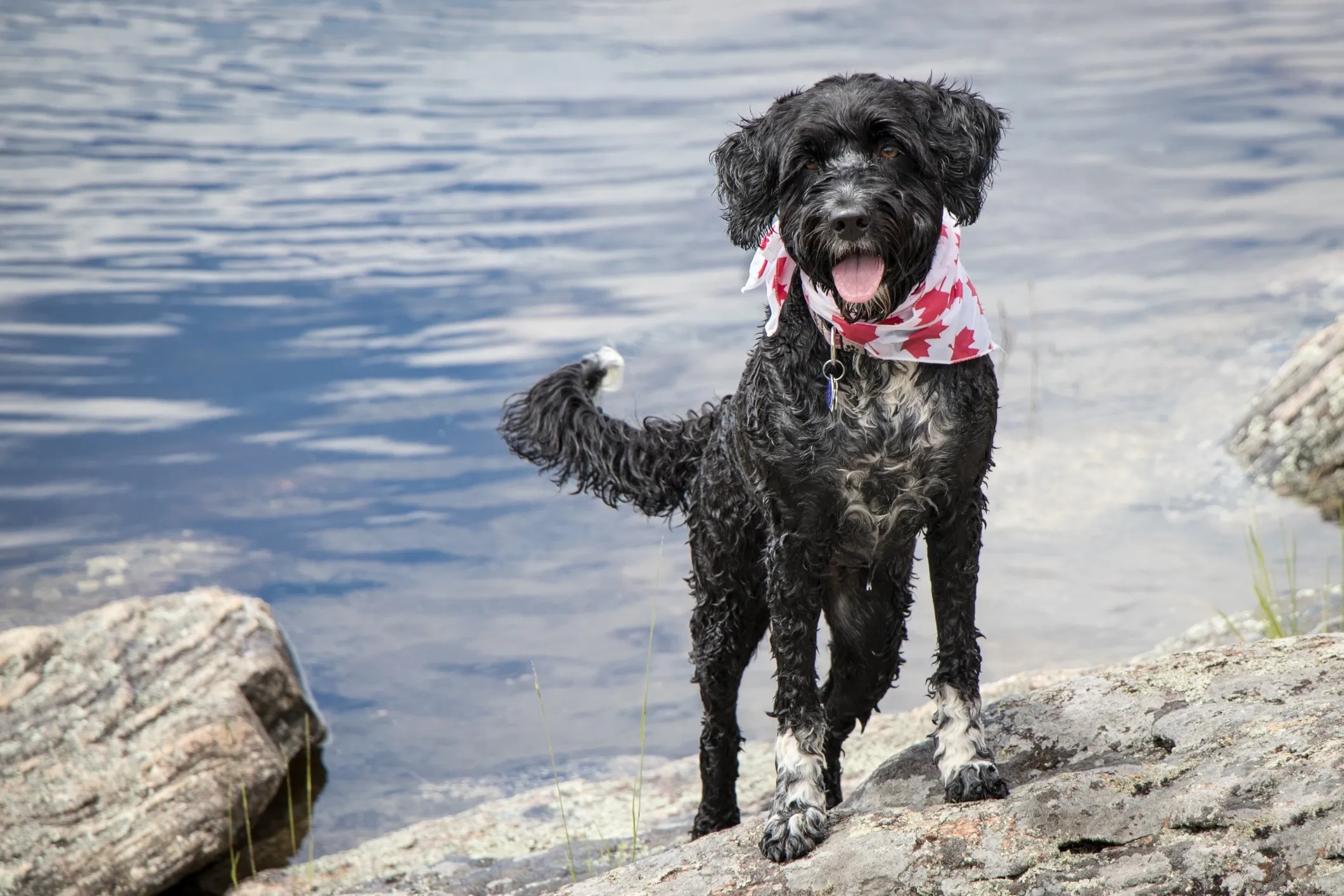 A black and white Portuguese Water Dog wearing a red maple leaf bandana, sitting attentively in front of a calm body of water
A black and white Portuguese Water Dog wearing a red maple leaf bandana, sitting attentively in front of a calm body of water
10. Labradoodle
The Labradoodle is a popular crossbreed resulting from a Labrador Retriever and a Poodle. Originally bred to be a hypoallergenic service dog, they have gained widespread popularity as family pets. Labradoodles are known for their intelligence, friendly nature, and gentle demeanor. They are highly trainable and make excellent companions, especially when properly exercised and socialized from a young age. Their coats can vary in texture (wavy, curly, or fleecy) but are generally low-shedding, inherited from their Poodle parent. Regular grooming is necessary to prevent their coats from matting and to keep them clean.
11. Goldendoodle
Another popular “doodle” breed, the Goldendoodle, is a cross between a Golden Retriever and a Poodle. Like Labradoodles, these dogs are highly intelligent, possess a friendly nature, and are known for their low-shedding coats. While often recognized for their golden hues, Goldendoodles can exhibit a wide range of colors and coat textures. Their affectionate and playful personalities make them wonderful family pets. Due to their curly or wavy coats, frequent grooming with a slicker brush is crucial to prevent matting and maintain their beautiful appearance. They are energetic dogs that benefit from regular exercise and mental stimulation.
12. Lagotto Romagnolo
The Lagotto Romagnolo, an ancient Italian breed, was originally bred as a water retriever and is notable for its curly, woolly coat that offers protection in cold waters. These charming dogs are considered low-shedding and can be excellent family pets, getting along well with children and other pets. While less common than some other low-shedding breeds, their intelligent and eager-to-please nature makes them highly trainable. Their rustic coat requires regular grooming to prevent matting, often needing a trim a few times a year to maintain its structure and cleanliness. Lagotto Romagnolos are active dogs that enjoy outdoor activities and mental challenges.
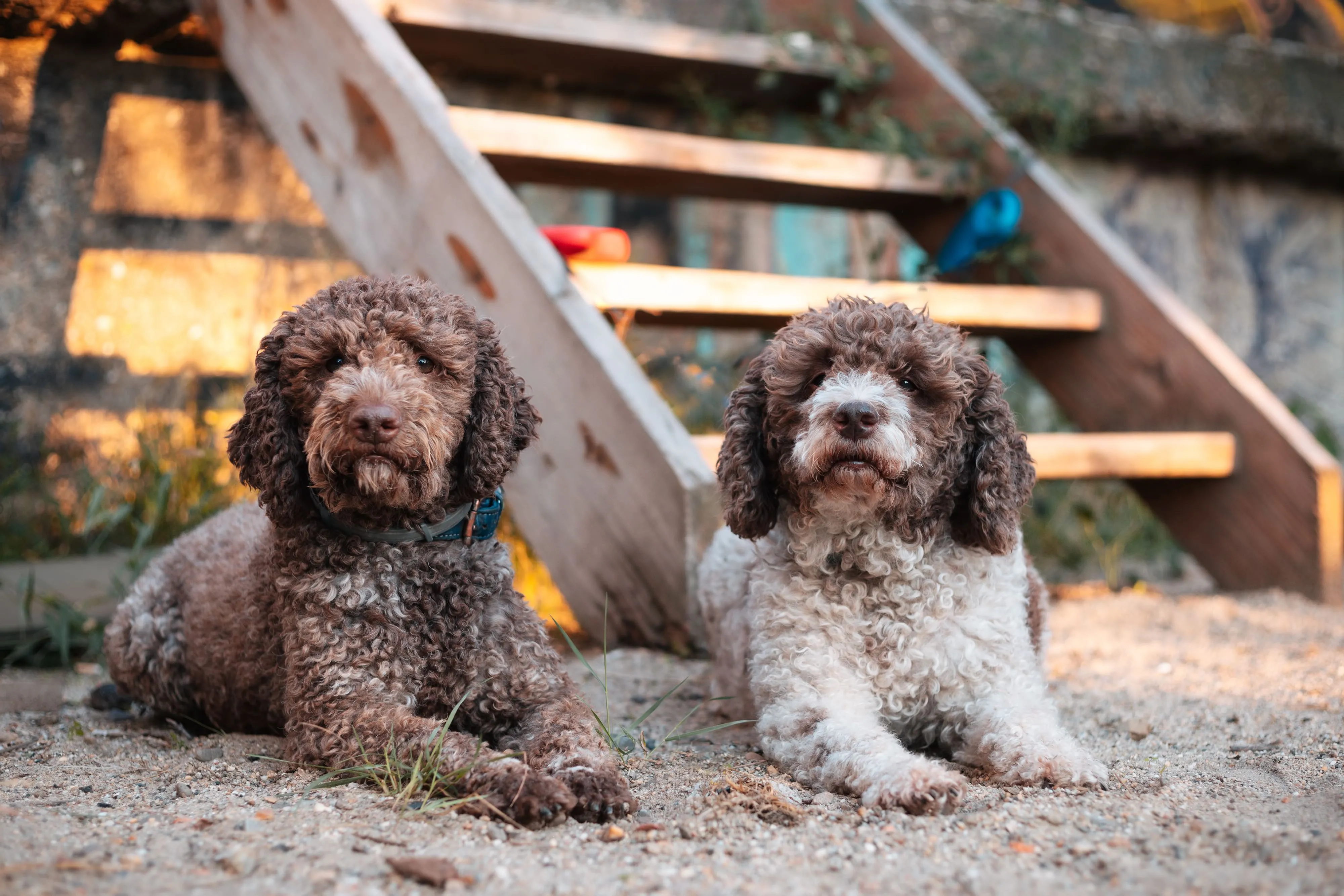 Two Lagotto Romagnolo dogs with curly coats lying on the ground, looking directly at the camera with inquisitive expressions
Two Lagotto Romagnolo dogs with curly coats lying on the ground, looking directly at the camera with inquisitive expressions
13. Affenpinscher
Affenpinschers are small, spirited dogs known for their distinctive monkey-like facial expressions. Their dense, wiry coats are low-shedding, producing fewer allergens compared to many other breeds. However, this unique coat requires dedicated care, including regular at-home brushing and occasional hand-stripping. Hand-stripping is a grooming process where the hair is manually removed by the root, rather than trimmed, to maintain the coat’s proper texture and color. These charming dogs are playful and curious, often described as mischievous, and form strong bonds with their families. They adapt well to apartment living but enjoy daily walks and playtime.
14. Irish Water Spaniel
The Irish Water Spaniel is a distinguished water dog breed, originally developed for retrieving game from water. These intelligent, friendly, and highly trainable dogs possess a thick, curly coat that sheds minimally, making them a good option for allergy sufferers. Their coat is always liver (brown) in color and requires regular grooming to keep it healthy and free of mats. Irish Water Spaniels have high energy levels and require substantial daily exercise to remain happy and well-behaved. Their love for water makes swimming an ideal activity for them, helping to burn off energy and provide mental stimulation.
15. Aussiedoodle
An Aussiedoodle is a cross between an Australian Shepherd and a Standard or Miniature Poodle, inheriting intelligence and high energy from both parent breeds. This low-shedding dog is known for being very smart and exceptionally energetic. Due to their intelligence and activity levels, Aussiedoodles require plenty of exercise and mental stimulation to prevent boredom, which can lead to destructive behaviors. Enrichment toys, puzzle feeders, and engaging training sessions are excellent ways to keep an Aussiedoodle happy and well-adjusted. Their coats can vary, but generally lean towards the Poodle’s low-shedding characteristics, requiring regular brushing to prevent tangles.
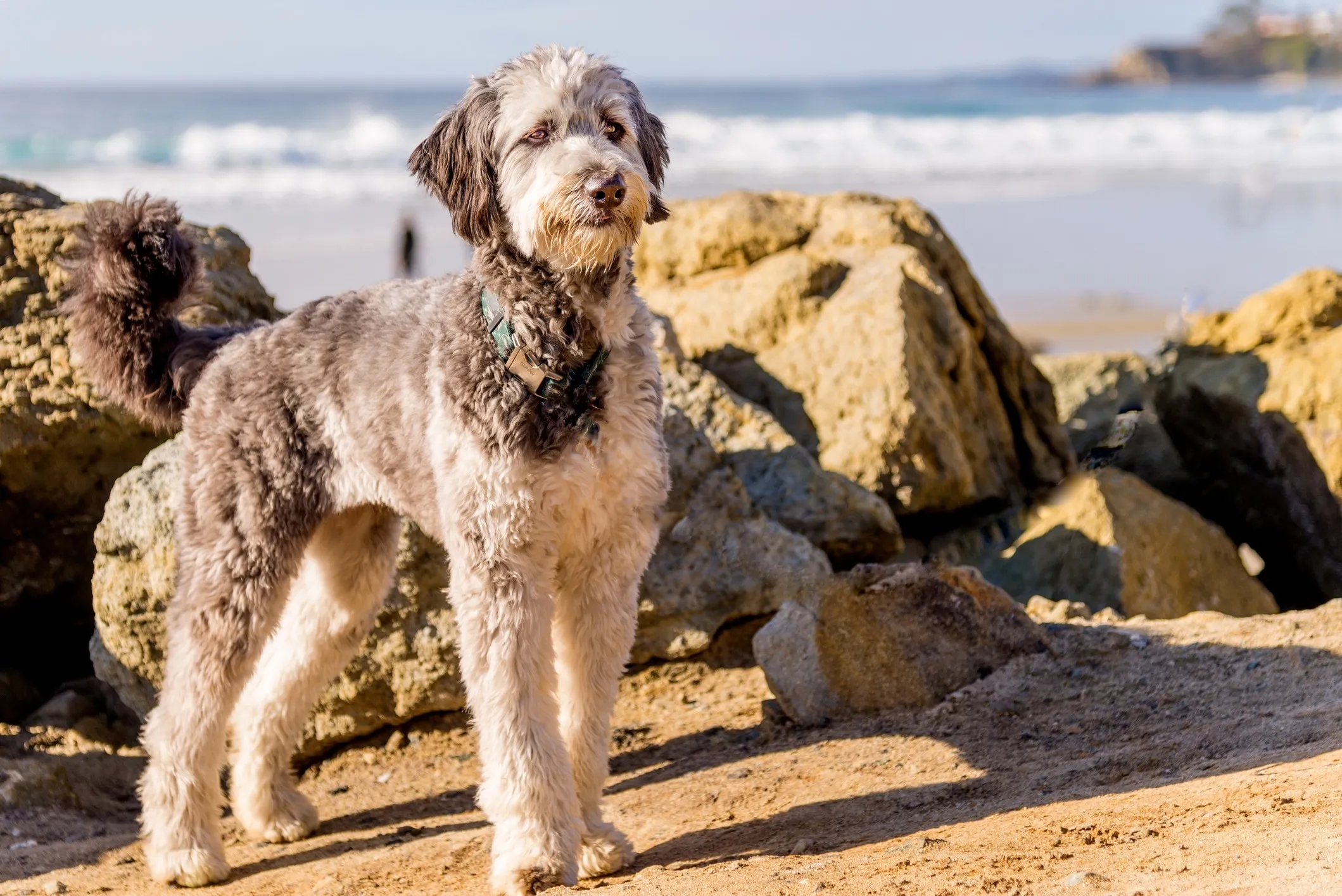 A beautiful standard Aussiedoodle dog standing gracefully on a sandy beach with the ocean in the background
A beautiful standard Aussiedoodle dog standing gracefully on a sandy beach with the ocean in the background
16. Bolognese
Bolognese dogs are adorable, small low-shedding pups that originated in Italy. They are characterized by their long, fluffy white coats, which, despite their sometimes messy appearance, require considerable grooming to stay in good condition. These playful and easygoing dogs are known for getting along well with children and other pets, making them versatile companions that can adapt to various living situations, including apartments. Bolognese thrive on companionship and enjoy being close to their human family members. Their charming personalities and low-shedding coats make them a delightful choice for many households.
17. Maltese
The Maltese is a small, aristocratic dog breed celebrated for its luxurious, flowing white coat. This breed is known for being low-shedding, making them a favored choice among dog breeds that don’t shed hair, particularly for those with allergies. Maltese are affectionate and playful companions who thrive on interaction with their pet parents. Their impressive coats require significant grooming dedication, especially if maintained long. Many owners opt for a shorter “puppy cut” to simplify daily care. Regular brushing and professional grooming appointments are essential to prevent matting and keep their silky hair in pristine condition.
18. Soft Coated Wheaten Terrier
The Soft Coated Wheaten Terrier is a medium-sized Irish breed aptly named for its incredibly soft, silky coat that has a distinctive wheaten color. This breed is cherished for its low-shedding qualities. As terriers, Wheatens maintain a high energy level throughout their lives and require ample exercise and mental stimulation to be well-behaved and happy. They are known for their joyful and exuberant personalities, often greeting people with the “Wheaten Greetin'”—a jump-up, lick-your-face display of affection. Regular brushing is important to prevent their soft coats from matting, and professional grooming is often recommended to maintain their distinctive look.
 A Soft Coated Wheaten Terrier dog playfully balancing on a log in a natural outdoor setting
A Soft Coated Wheaten Terrier dog playfully balancing on a log in a natural outdoor setting
19. Coton de Tulear
Originating from Madagascar, the Coton de Tulear is a small, easygoing low-shedding breed. Their characteristic cotton-like coat is soft, fluffy, and sheds minimally, contributing to their appeal for allergy sufferers. Cotons are known for their good nature, making them excellent companions for other pets and children, especially when introductions are handled properly. They are playful, intelligent, and thrive on human companionship, often becoming very attached to their families. Despite their playful energy, they adapt well to various living environments. Regular brushing is crucial to prevent their unique coat from matting.
20. Schnoodle
The Schnoodle is a designer breed that combines two low-shedding breeds: the Schnauzer and the Poodle. This makes them an ideal choice for those specifically seeking dog breeds that don’t shed hair. Their coat can be curly or wavy, depending on the traits inherited from their parents, but it is consistently low-shedding. Schnoodles are known for their intelligence, playful nature, and affectionate personalities, making them wonderful family pets. They benefit from regular exercise and mental engagement. Like their parent breeds, Schnoodles require consistent grooming to keep their coats healthy and tangle-free.
21. Bedlington Terrier
Often described as “a lamb in dog’s clothing,” the Bedlington Terrier is a small, curly-haired breed recognized by its distinctive topknot hairdo and pom-pom ear tufts. This unique coat sheds very little, placing them firmly on the list of low-shedding dogs. Bedlington Terriers are devoted to their human companions and love to be by their side. They can develop separation anxiety if left alone for extended periods, so a family member who is frequently home or arrangements for companionship are important. These elegant dogs are lively and require regular exercise to channel their energy. Their specific coat type necessitates regular professional grooming to maintain their iconic appearance.
22. Xoloitzcuintli (Mexican Hairless Dog)
The Xoloitzcuintli, or Mexican Hairless Dog, is one of the oldest and rarest dog breeds, with a history dating back thousands of years. This breed comes in three sizes (toy, miniature, and standard) and can be either hairless or coated. Both varieties are considered low-shedding. The hairless Xolo, as its name suggests, is largely devoid of hair, contributing to its hypoallergenic qualities. The coated Xolo has a short, smooth coat that also sheds minimally. Xolos are known for being calm, intelligent, and loyal companions. The hairless variety requires skin care to protect against sun and cold, while the coated variety is relatively low-maintenance in terms of grooming.
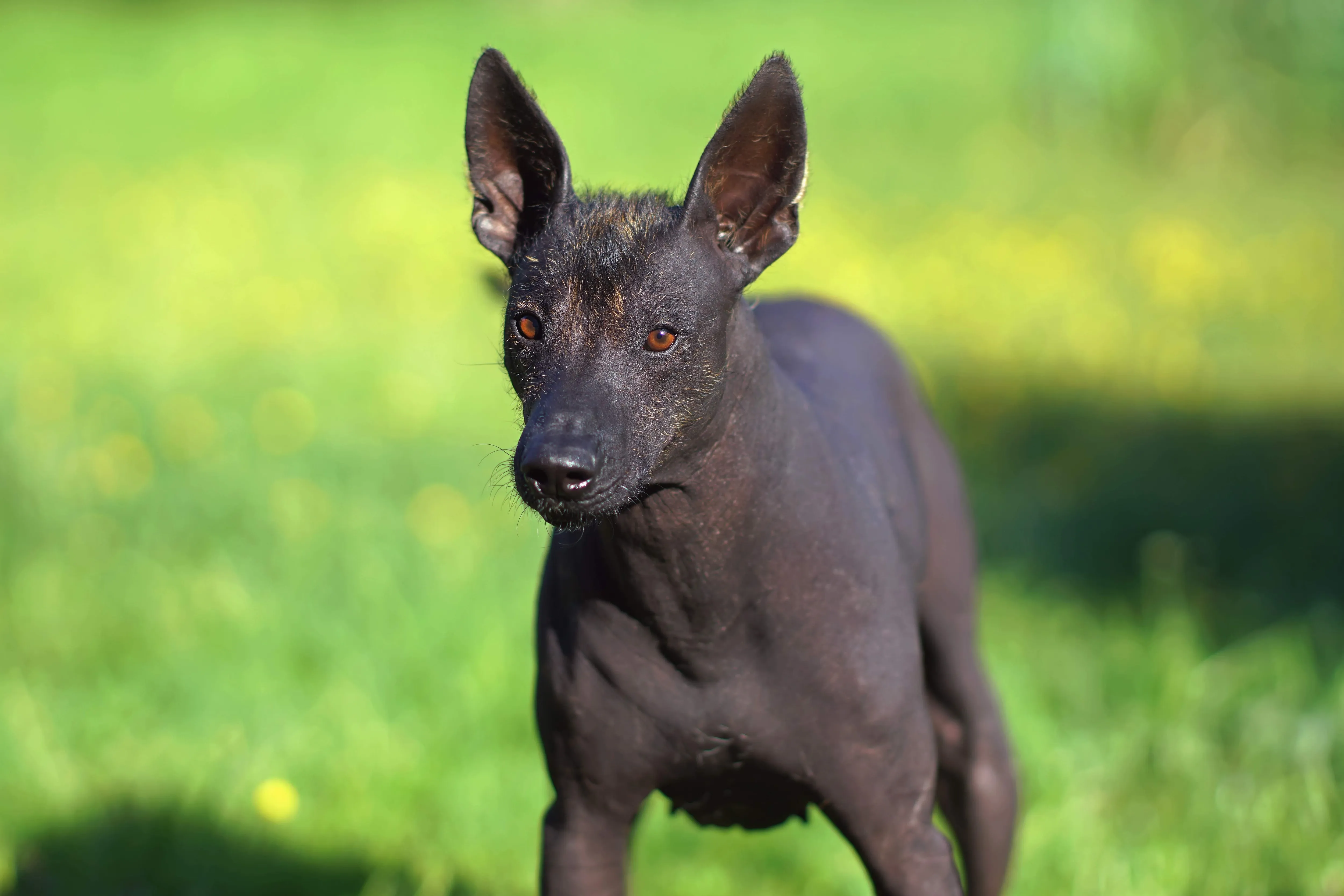 A black Mexican Hairless Dog (Xoloitzcuintli) standing gracefully in a field of green grass, looking alertly at the camera
A black Mexican Hairless Dog (Xoloitzcuintli) standing gracefully in a field of green grass, looking alertly at the camera
23. Whoodle
A Whoodle is a charming crossbreed created by combining a Soft-Coated Wheaten Terrier with a Poodle. This results in a friendly, intelligent dog that sheds very minimally, making them an excellent choice for allergy sufferers. Whoodles inherit their affectionate nature and keen intelligence from both parent breeds. They are playful and energetic, thriving on interaction and activity with their families. Their soft, wavy to curly coats are low-shedding but require regular brushing to prevent tangles and mats. Whoodles adapt well to various living situations as long as they receive consistent exercise and mental engagement.
24. Bernedoodle
Bernedoodles are a cross between Bernese Mountain Dogs and Poodles, resulting in large, affectionate, and gentle low-shedding dogs. Their friendly nature and calm demeanor make them a popular choice for families with children and other pets, provided they are well-socialized. Bernedoodles are energetic and require plenty of exercise to stay happy and healthy. Their coats, which can range from wavy to curly, are low-shedding thanks to their Poodle heritage but do require regular grooming to prevent matting. These intelligent dogs benefit from consistent training and mental stimulation to thrive.
25. Shorkie
The Shorkie is a mixed breed combining two low-shedding dogs: the Shih Tzu and the Yorkshire Terrier. This delightful crossbreed offers the best traits of both parent breeds, resulting in a small, playful, and friendly companion. Shorkies are affectionate and enjoy being close to their human family members. While they are low-shedding, they require a regular grooming routine, including daily brushing, to keep their fine hair free of tangles and mats. Their small size makes them adaptable to apartment living, and their lively personalities ensure there’s never a dull moment. dog breeds which don t shed hair
26. Afghan Hound
Afghan Hounds are striking dogs known for their long, flowing coats and slender, elegant builds. Despite their voluminous hair, they are considered low-shedding due to their unique hair texture, which is more like human hair. These regal pups are built for speed and are among the fastest dog breeds in the world. Afghan Hounds are loving and devoted to their families but can be quite aloof and independent towards strangers. Early and consistent socialization is vital for this breed to ensure they are well-adjusted. Their magnificent coats require extensive daily grooming to prevent tangles and mats and maintain their iconic appearance.
27. Barbet
The Barbet, pronounced “bar-bay,” is a cheerful and shaggy pup with a woolly, curly coat. The name “Barbet” comes from the French word “barbe,” meaning beard, which points to their characteristically hairy chin. This large low-shedding dog loves to swim, a trait facilitated by their protective curly coat. Barbets are known for their friendly and outgoing personalities, making them great companions. To keep their coat in good condition, especially after swimming, they require regular brushing with a slicker or pin brush two to three times a week, along with professional grooming to manage their dense curls.
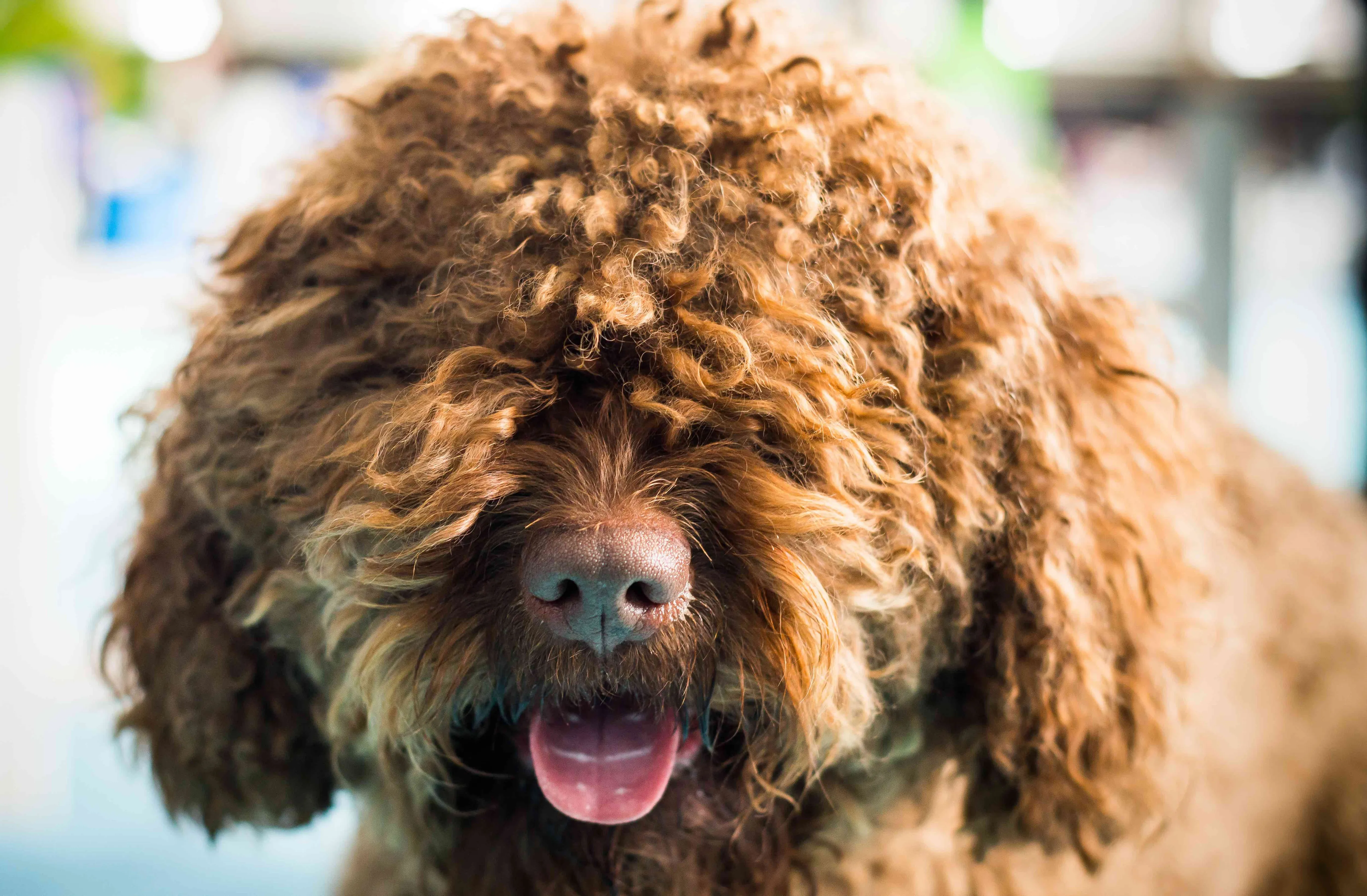 A close-up of a curly red Barbet dog's face, highlighting its characteristic shaggy and woolly fur
A close-up of a curly red Barbet dog's face, highlighting its characteristic shaggy and woolly fur
28. Shih-Poo
The Shih-Poo is a charming mixed breed, typically a cross between a Shih Tzu and a Toy Poodle. This small, low-shedding pup adapts well to almost any living situation, making them suitable for apartment dwellers or those with smaller homes. Shih-Poos are known for their affectionate and playful natures, thriving on human companionship. They generally require about 30 minutes of exercise daily, along with a good brushing session to keep their coats free of tangles. Their coats can vary in texture, but they consistently exhibit low-shedding qualities, making them another excellent choice for allergy-sensitive households.
29. Peruvian Inca Orchid
Peruvian Inca Orchids are rare ancient dog breeds that are considered low-shedding thanks to their often nearly hairless bodies. They are the national dog of Peru and come in three sizes: small, medium, and large. While most are hairless, some coated varieties exist, also featuring a very short coat that sheds minimally. These dogs are known for their elegant appearance, intelligence, and sensitive nature. The hairless variety requires protection from the sun and cold, emphasizing the need for appropriate clothing and skincare. They are loyal and protective of their families, making excellent companions for those who appreciate their unique qualities.
30. Malshi
As a cross between the Maltese and Shih Tzu, the Malshi is a happy, small, and low-shedding dog. They are known for thriving on close companionship and forming strong bonds with their favorite humans. Malshis are affectionate, playful, and generally well-behaved, making them delightful family pets. Like most low-shedding breeds with longer coats, they require dedication to a regular grooming routine, including daily brushing, to prevent mats and keep their coat healthy and shiny. Their small size and gentle nature make them suitable for a variety of households, offering companionship without excessive shedding.
Tips for Living with a Low-Shedding Dog
While choosing a dog breed that doesn’t shed hair can significantly reduce allergen exposure, adopting certain practices can further minimize allergic reactions and ensure a harmonious home environment.
Keep Up With Grooming
Even low-shedding dogs require regular grooming and maintenance to ensure a clean and allergen-minimized home. Consistent brushing helps to remove loose hairs and dander that might still be present, preventing them from becoming airborne. Ideally, dogs should be groomed weekly, and bathed every four to six weeks. Using special shampoos formulated to reduce pet dander can be particularly beneficial for pet parents with allergies. Many low-shedding breeds also need regular trimming, hand-stripping, or other specialized grooming upkeep. Factor in the budget for professional groomers or commit to learning at-home grooming techniques.
Maintain a Clean House
Minimizing allergens in the home goes beyond just grooming your dog. Regular cleaning and maintenance of your living space are crucial. Vacuuming frequently with a HEPA filter vacuum, dusting surfaces regularly, and washing bedding (both yours and your dog’s) can significantly reduce the accumulation of pet dander. Utilizing air purifiers with HEPA filters and ensuring good ventilation throughout your house can also help to remove airborne allergens, creating a healthier environment for allergy sufferers. Consider designating certain areas of the house as pet-free zones, especially bedrooms.
Talk to Your Doctor
Managing allergies is a personal journey, and consulting with your healthcare provider is the best way to develop an effective strategy. There are many ways to treat and manage allergies, including over-the-counter medications, prescription nasal sprays, and allergy injections (immunotherapy). Your doctor can help you determine the most suitable approach for your specific needs. Additionally, it’s important to be mindful that even with a low-shedding dog, allergens are present in their skin, saliva, and urine. Therefore, avoiding close contact with these bodily fluids, such as letting the dog lick your face, can help prevent allergic reactions.
Bringing home a dog from the selection of breeds that don’t shed hair can be a transformative experience for individuals with allergies. These dogs offer the immense joy and companionship of pet parenthood, allowing allergy sufferers to share their lives with a canine friend without the constant worry of severe allergic reactions. With proper research, diligent grooming, and a clean living environment, finding your perfect low-shedding companion is entirely possible.
Explore more breeds and dog care tips on Dog Care Story!
